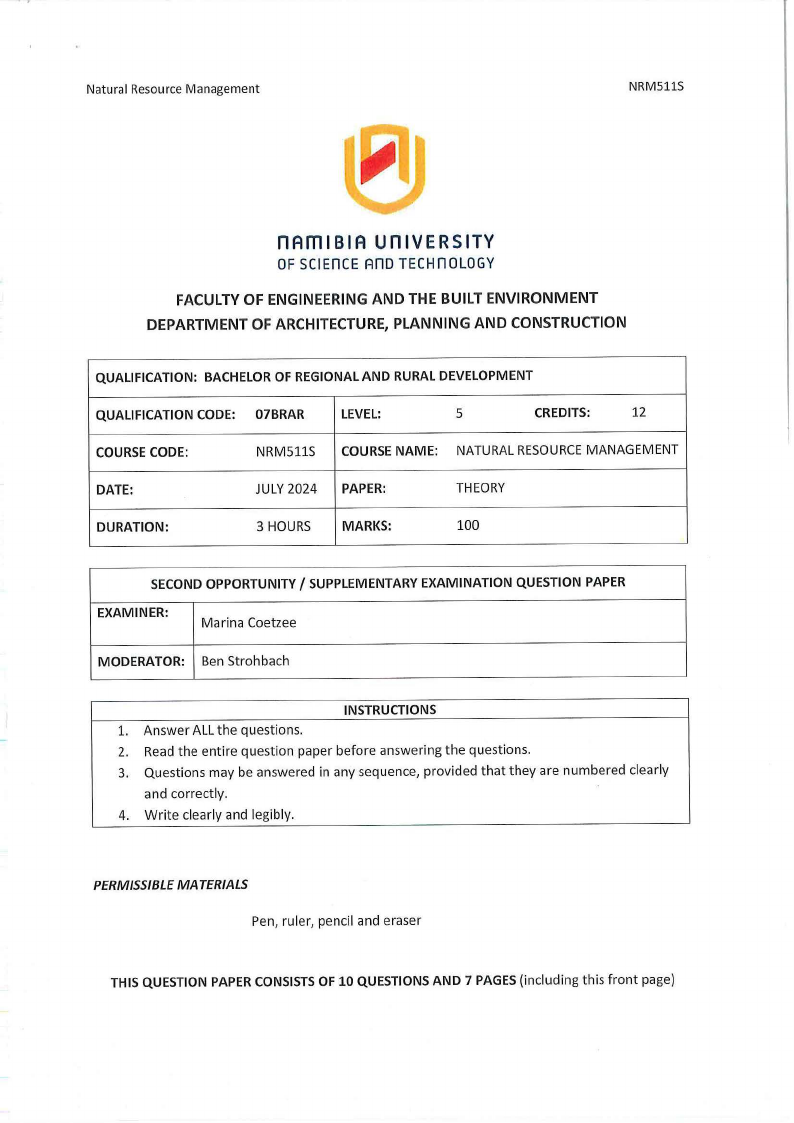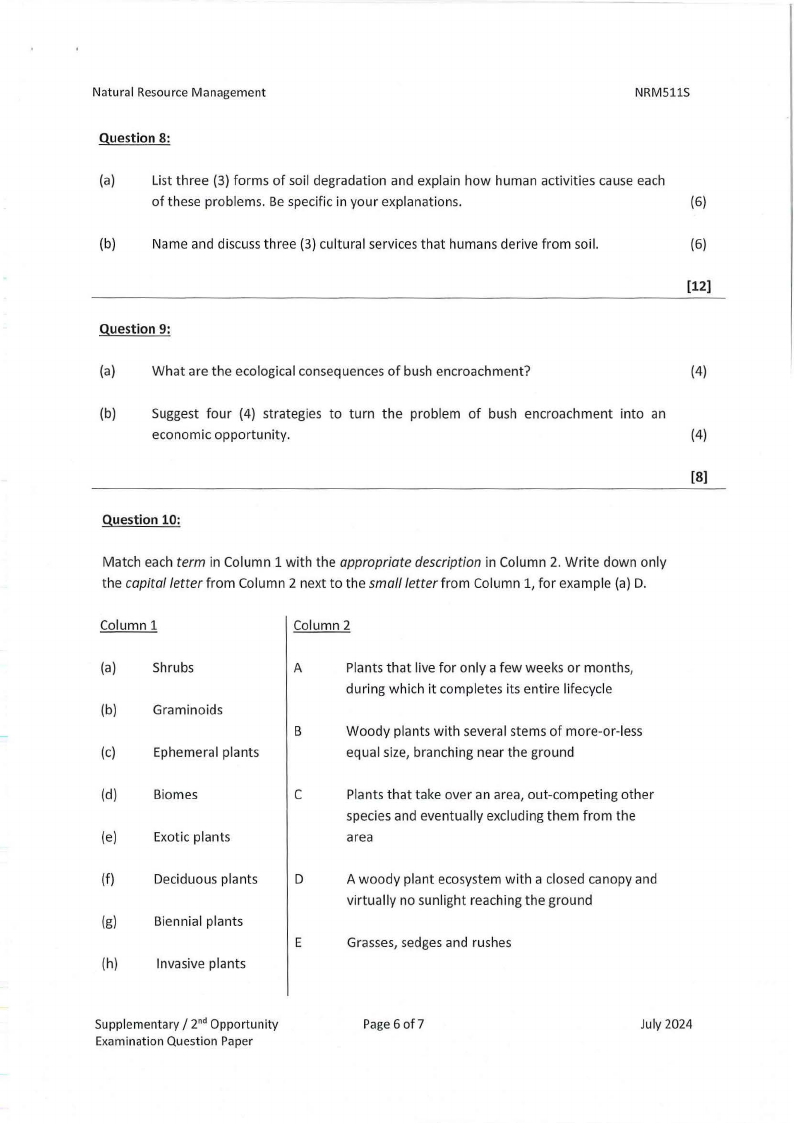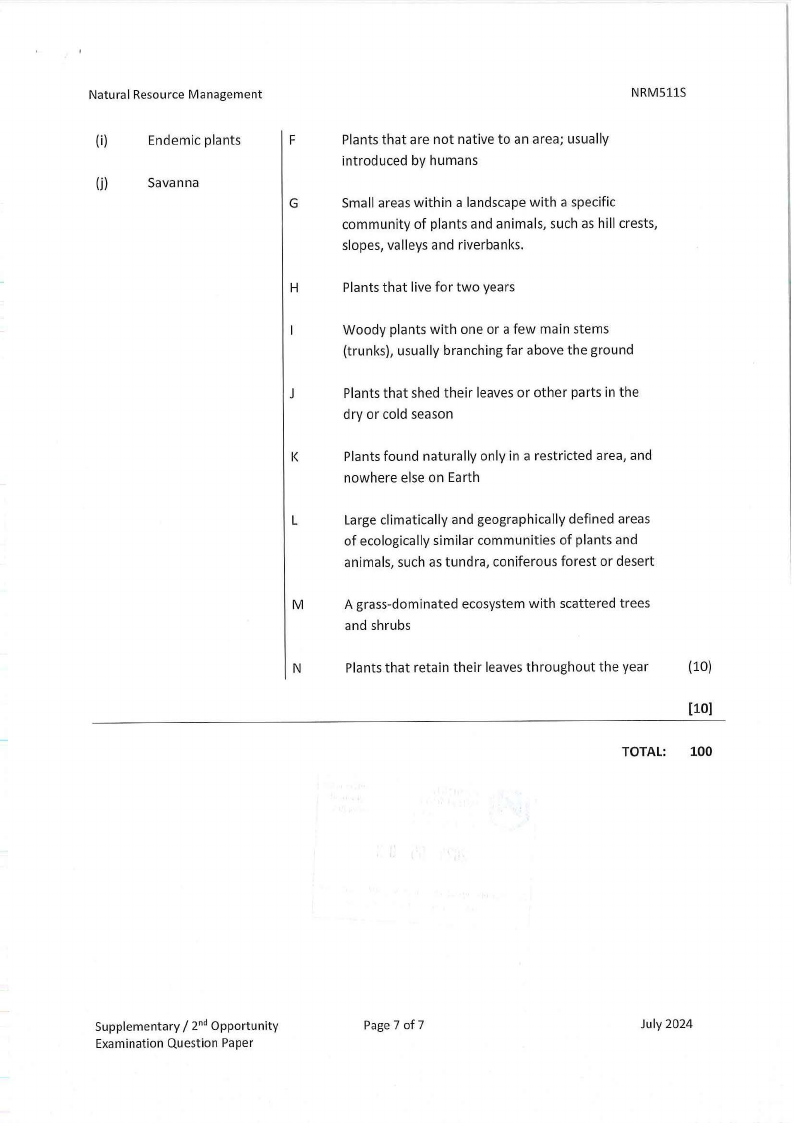 |
NRM511S - NATURAL RESOURCE MANAGEMENT - 2ND OPP - JULY 2024 |
 |
1 Page 1 |
▲back to top |

Natural Resource Management
NRM511S
n Am I BI A u n IVE Rs ITY
OF SCIEnCE Ano TECHnOLOGY
FACULTYOF ENGINEERINGAND THE BUILTENVIRONMENT
DEPARTMENTOF ARCHITECTUREP, LANNINGAND CONSTRUCTION
QUALIFICATION: BACHELOROF REGIONALAND RURALDEVELOPMENT
QUALIFICATIONCODE: 07BRAR
LEVEL:
5
CREDITS:
12
COURSECODE:
NRMSllS
COURSENAME: NATURALRESOURCEMANAGEMENT
DATE:
JULY 2024 PAPER:
THEORY
DURATION:
3 HOURS MARKS:
100
SECONDOPPORTUNITY/ SUPPLEMENTARYEXAMINATION QUESTION PAPER
EXAMINER:
Marina Coetzee
MODERATOR: Ben Strohbach
INSTRUCTIONS
1. Answer ALL the questions.
2. Read the entire question paper before answering the questions.
3. Questions may be answered in any sequence, provided that they are numbered clearly
and correctly.
4. Write clearly and legibly.
PERMISSIBLEMATERIALS
Pen, ruler, pencil and eraser
THIS QUESTION PAPERCONSISTSOF 10 QUESTIONSAND 7 PAGES(including this front page)
 |
2 Page 2 |
▲back to top |

Natural Resource Management
NRMS11S
Question 1:
Select the single CORRECTanswer to each of the following questions. Just write down the
number, e.g. (a) D.
(a)
Keetmanshoop's water supply source is the ....
A Otjivero Dam
B Karst Aquifer
C Grootfontein-Omatako Canal
D Kuiseb Aquifer
E Naute Dam
(1)
(b)
The capacity of the environment to absorb, neutralise or recycle wastes is called ...
A perpetual resources
B ecosystems
C renewable resources
D sinks
E provisioning services
(1)
(c)
Arboricides are used to kill ...
A weeds
B mosquitoes
C snails
D bushes
E parasitic worms
(1)
(d)
The major international convention and protocol for the protection of the ozone
layer are the ....
A Vienna Convention and Montreal Protocol
B UNFCCCConvention and Paris Agreement
C UNCBD Convention and Kyoto Protocol
D UNCCDConvention and Ramsar Protocol
E Ramsar Convention and Paris Agreement
(1)
(e)
Bio-magnification ....
A happens when an organism eats contaminated organisms that are lower on the food
chain
B is responsible for unhealthy sleep patterns in humans
C happens only in ocean food webs
D happens when a pollutant enters an organism from its physical environment
E is caused by depletion of the ozone layer
(1)
Supplementary/ 2nd Opportunity
Examination Question Paper
Page 2 of7
July 2024
 |
3 Page 3 |
▲back to top |

Natural Resource Management
NRM5115
(f)
The estimated percentage of Namibian precipitation that evaporates very soon after
rains is ....
A 100%
B 83 %
C 14%
D 2%
E 1%
(1)
(g)
Alien invasive species does not harm indigenous biodiversity through ....
A competition for habitats
B predation
C competition for mates
D being vectors (carriers) of diseases
E competition for food
(1)
(h)
Which one of the following is the major anthropogenic greenhouse gas?
A carbon dioxide
B ozone
C chlorofl uoroca rbon
D oxygen
E nitrogen
(1)
( i)
The form of light pollution in which a light source is a nuisance, such as a neighbour's
outdoor light shining into your bedroom, is ...
A
skyglow
B
light clutter
C
glare
D
light trespass
E
colour blindness
(1)
(j)
Monoculture refers to ....
A One culture being dominant in society
B The growing of one crop over a large area of land, year after year
C Marine organisms (such as oysters) produced commercially for food
D Production of monotremes, a type of freshwater fish
E Crops being grown by individuals for their own consumption
(1)
[10)
Supplementary/ 2nd Opportunity
Examination Question Paper
Page3 of 7
July 2024
 |
4 Page 4 |
▲back to top |

Natural Resource Management
NRM511S
Question 2:
(a)
Pollution can appear as physical objects, chemical substances, or harmful energy.
Provide two (2) examples of pollution in the form of energy, and briefly explain their
negative effects. Be specific.
(4)
(b)
Differentiate between waste and pollution.
(3)
(c)
In the 'hierarchy of waste management', disposal in a landfill is the least desirable
option. What are the preferred methods of waste management?
(4)
[11)
Question 3:
(a)
What is ozone?
(2)
(b)
Explain the mechanism through which the depletion of stratospheric ozone affects
ocean food webs and plant health.
(3)
(c)
What are the effects of tropospheric (ground-level) ozone pollution on human health? (3)
[8]
Question 4:
(a)
"In addition to climate change, the burning of fossil fuels causes ocean acidification."
Debate this statement.
(3)
(b)
Why does ocean acidification pose a threat to marine ecosystems and food webs?
(3)
(c)
Climate change has geopolitical implications. How can climate change cause or
worsen conflict between countries and within societies?
(3)
(d)
When Arctic (northern polar region) ice melts, the newly exposed, darker land and
ocean absorb more solar radiation and warm up faster than when 'they were covered
by ice. This warming causes ice to melt faster, exposing more land and ocean, and the
cycle repeats itself over and over, and speeds up. Such a self-reinforcing process is
known as a positive feedback loop.
Supplementary/ 2nd Opportunity
Examination Question Paper
Page 4 of 7
July 2024
 |
5 Page 5 |
▲back to top |

Natural Resource Management
NRM511S
Name two {2) more positive feedbacks in the climate system that can speed up and
possibly cause run-away climate change.
(2)
[11]
Question 5:
(a)
Identify three {3) of the most important pressures (threats) on biodiversity.
{3)
(b)
There are broad global biodiversity patterns that are shaped by environmental
conditions. For example, diversity is usually higher near sea level than in high
mountains. Explain the general global biodiversity distribution in relation to rainfall,
temperature, and nutrient levels.
(3)
(c)
Provide examples of two (2) ways in which living organisms regulate environmental
processes, with a short explanation of each.
(4)
[10]
Question 6:
(a)
Explain the respective roles of the Namibian Ministry of Agriculture, Water and Land
Reform, NamWater, and local authorities in water supply.
(6)
(b)
What is managed (artificial) aquifer recharge, why is it done and how is it applied in
Namibia?
(6)
[12]
Question 7:
(a)
Differentiate between a hydrological drought and an agronomic (crop) drought.
{3)
(b)
Propose a scenario that could cause an area to suffer a hydrological drought, but not
an agronomic drought.
(2)
(c)
Describe the typical characteristics of drylands.
(3)
[8]
Supplementary/ 2nd Opportunity
Examination Question Paper
Page 5 of 7
July 2024
 |
6 Page 6 |
▲back to top |

Natural Resource Management
NRM511S
Question 8:
(a)
List three (3) forms of soil degradation and explain how human activities cause each
of these problems. Be specific in your explanations.
(6)
(b)
Name and discuss three (3) cultural services that humans derive from soil.
(6)
[12)
Question 9:
(a)
What are the ecological consequences of bush encroachment?
(4)
(b)
Suggest four (4) strategies to turn the problem of bush encroachment into an
economic opportunity.
(4)
[8)
Question 10:
Match each term in Column 1 with the appropriate description in Column 2. Write down only
the capital letter from Column 2 next to the small letter from Column 1, for example (a) D.
Column 1
Column 2
(a)
Shrubs
A
(b)
Graminoids
B
(c)
Ephemeral plants
Plants that live for only a few weeks or months,
during which it completes its entire lifecycle
Woody plants with several stems of more-or-less
equal size, branching near the ground
(d)
Biomes
(e)
Exotic plants
C
Plants that take over an area, out-competing other
species and eventually excluding them from the
area
(f)
Deciduous plants
D
(g)
Biennial plants
E
(h)
Invasive plants
A woody plant ecosystem with a closed canopy and
virtually no sunlight reaching the ground
Grasses, sedges and rushes
Supplementary/ 2nd Opportunity
Examination Question Paper
Page 6 of7
July 2024
 |
7 Page 7 |
▲back to top |

Natural Resource Management
(i)
Endemic plants
F
(j)
Savanna
G
H
J
K
L
M
N
NRM511S
Plants that are not native to an area; usually
introduced by humans
Small areas within a landscape with a specific
community of plants and animals, such as hill crests,
slopes, valleys and riverbanks.
Plants that live for two years
Woody plants with one or a few main stems
(trunks), usually branching far above the ground
Plants that shed their leaves or other parts in the
dry or cold season
Plants found naturally only in a restricted area, and
nowhere else on Earth
Large climatically and geographically defined areas
of ecologically similar communities of plants and
animals, such as tundra, coniferous forest or desert
A grass-dominated ecosystem with scattered trees
and shrubs
Plants that retain their leaves throughout the year
(10)
[10)
TOTAL: 100
Supplementary/ 2nd Opportunity
Examination Question Paper
Page 7 of 7
July 2024





